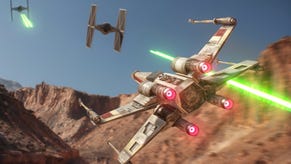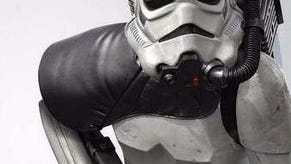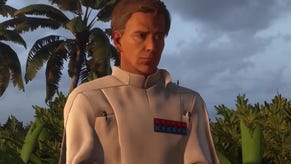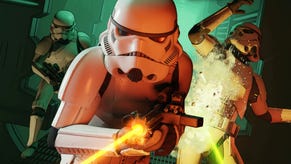Face-Off: Star Wars Battlefront vs Return of the Jedi
Capture mashed up with movie footage shows us how far graphics have come.
There's something about the speeder bike chase segment in Return of the Jedi that proves utterly irresistible to game developers. It's got to be the sheer speed and exhilaration of the sequence, plus its heavy reliance on first-person viewpoints to frame the action. Along with the Death Star trench segment, it's one of the few movie experiences that should translate almost seamlessly into gameplay. The only problem is - as countless titles over the last 32 years have demonstrated - gaming technology just doesn't have the raw power available to bring that iconic battle into playable life. Until now, perhaps.
Star Wars Battlefront brings the forest moon of Endor to life beautifully - a combination of beautifully rich detail backed with one of the most accomplished real-time lighting models in the business. Then there's the motion blur - a key component in replicating the speeder bike experience - and here, once again, DICE's technology does an uncanny job in replicating the source material. Which led us to wonder: just how close does Battlefront get to immersing you into a completely authentic Star Wars experience? Could we shift seamlessly between gameplay and movie footage?
We began our tests by splicing some Return of the Jedi footage with PlayStation 4 capture, and came away fairly impressed by the end result - but we knew that the Frostbite 3 engine had more to offer when paired with more formidable hardware. From there, we brought out the big guns to ensure the maximum possible visual quality from the game while reducing aliasing to an absolute minimum - we overclocked Nvidia's Titan X (the most powerful single-chip GPU on the market) and combined it with Intel's Core i7 6700K.
With settings ramped up to ultra, temporal anti-aliasing engaged and Battlefront's internal resolution scaling pushed to its 200 per cent limit, we captured at both 1920x1080 and 2560x1080 ultra-wide resolutions. We grabbed both 30fps and 24fps capture for testing purposes, opting for the latter in order to provide the closest match with the movie presentation. Our hardware dropped no frames here, and suffice to say that if you're willing to make some resolution cutbacks, running this experience at a locked 60fps is no problem at all - in fact, Battlefront is an eminently scalable game.
With capture complete, the clips were imported into Adobe Premiere Pro and the editing process began. DICE opts for a bright, vibrant presentation in order to make its visuals truly shine. It's a remarkable effort, but side-by-side with the movie, it doesn't quite work, necessitating some level of colour-grading in order to bring a closer level of consistency between game and film. Aliasing artefacts weren't really an issue, but shooting on film lends the movie a much softer appearance, so we added a Gaussian blur to the captures to get a similar aesthetic.
All of this post work could easily be done in real-time of course - it's just not the look that DICE was aiming for with its game. And let's be honest, a softer, filmic presentation isn't the best match for a fast-paced shooter - though we can look to Need for Speed 2015 for a look at how this lighting model integrates beautifully with this kind of aesthetic. There, Ghost Games is confident enough in the technology to integrate game engine assets directly into video sequences.
We're pleased with the end result of our mash-up here, but it is remarkable that one of the most iconic Star Wars sequences is relegated to tutorial mission status in Battlefront - and it has to be said that coming out of this mini-project, one of our big takeaways is how much a single-player component based on this technology is missed. Hopefully, the approach taken here will be integrated and perhaps even enhanced into Visceral's forthcoming Star Wars action game.

















